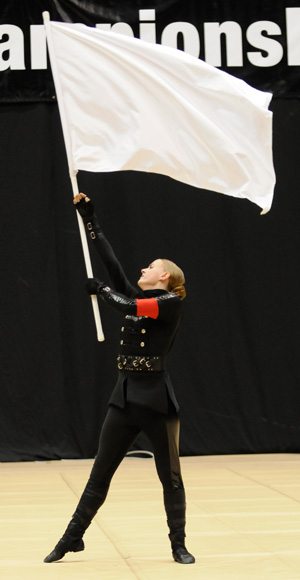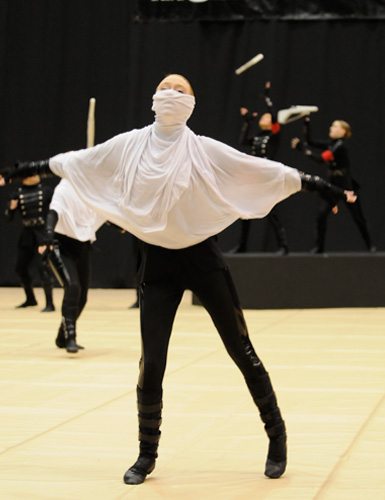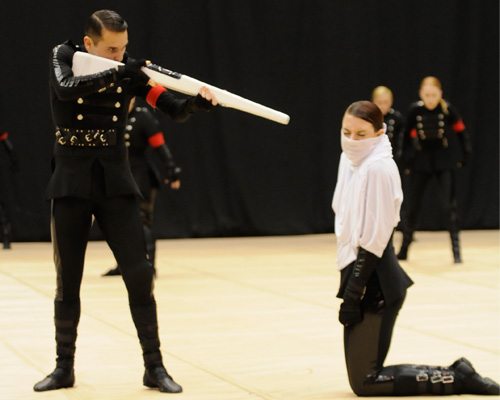By Dan Schack
Since I became aware of the indoor drumline and color guard activities, I’ve wondered what deems a show “controversial.” At some point throughout my experience marching drum corps and indoor drumline, I realized that the pageantry world is a generally accepting and open-minded place. Some of the most creative, out of the box thinkers I have ever encountered are people who gruel over the massive project of designing an 11 or 12 minute show, rehearsed and perfected for countless hours, set on a deadline, culminating with one final try. It’s kind of a biological art piece, breathing and pulsating, growing with its environment, adapting to changing times as it derives influence from a world that it also influences. To me, that is what is most exciting about WGI and all competitive pageantry.
What labels anything controversial is certainly based on who is receiving the message. When I think about the populations of those who attend shows, I am struck with an image of lots of young students, sometimes as young as elementary school. Alongside those students are parents, people who are invested in the wellbeing of their child and concerned with monitoring what their child is exposed to and when. Lastly, are the relatives and friends of performers who have come to see what this strange, hard to explain thing is all about. The smallest population consists of the instructors and designers who are the most familiarized with indoor pageantry. It is the last group to whom the wildly out of the box concepts seem generally acceptable. In a sense, we, as instructors and designers, become desensitized to the shock value of what is capable with a few drums, flags, instruments, and a gym.
Dating back to the early years of WGI, designers have put shows on the floor that were risky in how they could be received and a challenge in how they must be performed. Specific historical moments are reflected in any given year at WGI World Championships. In 2001, Mission Viejo’s winning percussion ensemble production, “XII”, featured a court hearing in which a person is found guilty and sentenced to punishment by death. Members were donned in all black with black blindfolds covering their eyes. The show’s climax – a performer is found guilty, shown bound to an electric chair as the background props change from black to red. Throughout the archives of WGI, shows have pushed the boundaries of the politically correct. What is so special about our activity is the way it reflects reality in any present moment. Like so many have said, “Art imitates life.”
Because of my interest in digging deeper into the thought process behind notable controversial shows, and the excitement surrounding Winter Guard International’s 40th anniversary in 2017, I will be featuring productions that are notorious for their controversial subject matter. I will be interviewing designers, instructors, and students involved in the production process to get an in depth look into what it is like to play a part in creating a controversial show.
To start, I had the incredible opportunity to catch up with Fantasia designer, Tim Mikan, to gain insight into the vision and process that drove their 2012 production “A Good German.”

What inspired the inception of the show? How does “A Good German” fit into contemporary color guard?
I have always been overwhelmed by the events of WWII. For most people, the atrocities that occurred are nearly impossible to comprehend. However, its story has been told through many idioms over the years, ranging from diaries to documentaries and music to blockbuster films – even many of our own color guards and marching bands have delved into this subject matter on some level. The caveat is that the events have always been told through the same perspective. I wanted to look at the story in a different way. The idea that a savage, emotionless, swastika wearing Nazi, a person who deserved no respect, no praise, no remembrance, could have been morally conflicted, was intriguing and something I felt worth exploring. This became my interest and ultimately the impetus for “A Good German.”
What musical selections inspired you? How did you arrive at the final selections?
I have been a fan of Gustav Mahler for some time. His music forces you to stop what you’re doing and listen. It’s some of the most introspective music I’ve ever heard. Mahler’s 9th Symphony brought me to tears the first time I heard it. It was gut wrenching. It left a mark on me – I knew it would be important to me in the future. With that said, it wouldn’t be fair of me to say that the show was born solely from subject matter alone. The music and the idea seemed to fuse almost instinctually. Side note: I thought it was interesting that Mahler’s work was considered repellent and disliked by Nazi Germany. So, in my mind, the “oil and water” nature of the “music and theme” reinforced the story of a soldier dealing with conflict…that cemented the marriage for me.
It seems like winter guard and the pageantry arts are never too far from their militaristic roots. Was this something that you kept in mind while designing this show?
Not so much because of the roots of our activity, but for the sake of the story. Military ranks and blocks were important to show conformity and strength; this was essential during the beginning of the show as we established mood. I thought it was necessary to highlight the soldier being recruited or indoctrinated into the organized group. It also served to foreshadow the conflict and disassociation the soldier would experience later in the show.
Did you have to train the members differently for “A Good German”? Did you take members who specifically had rifle experience so you could program around them?
Actually, I didn’t decide to use only rifles until around November of that year. All rifle is something I contemplated for a long time and I talked to the staff extensively before making the decision. In fact, one of the first parts of the show we workshopped was a flag build (one I really liked, by the way!) So no, we didn’t take members with rifle specifically in mind, but we do invest a lot of time on weapon at auditions, as most of our shows have the entire cast on rifle or sabre at some point.
The color guard was very strong that year, so as far as equipment and dance training, it started with business as usual. Then, we worked on rifle sharing on and off the boxes, partner work, and high risk tricks. There was also a difficult exchange series that took a lot of work – in fact, that was probably the hardest one we’ve done in a few years.
The most difficult part was the emotional zap felt by all of the performers. We joked and laughed, as any group does, but getting into “character” was very taxing on the members. They worked really hard to portray the tone of the story and often found themselves getting caught up in their own emotional investments. This was an aspect I anticipated, but not to the degree that actually occurred.
 Talk through the costuming and set design choices and other elements that strengthened the central concept of the show. Why the black uniforms, black platforms, and blank floor? What did these elements mean for the show?
Talk through the costuming and set design choices and other elements that strengthened the central concept of the show. Why the black uniforms, black platforms, and blank floor? What did these elements mean for the show?
When considering the design of the show, it was important to place as much emphasis on the performers as possible. Every year, I work closely with Jason Kramer, who is a terrific costume designer, to come up with a look that is unique, yet specific to the program we are working on. We talked about a few edgy looks that year and even considered going pretty abstract, but ultimately, I felt that the raw emotion of the show deserved most of the focus.
The stark black uniforms helped to carry the ominous “bad guy” look that we were trying to depict; especially against the beige floor. I knew that we would make the red armbands pretty important, so the black allowed us to place a lot of focus on them.
To preserve the military look, the hair and makeup were left clean; this also kept the show more gender neutral. I thought it was key that the performers looked strong and had a stoic presence, but not a specific identity.
The boxes served many purposes; they were stages, a break in the all beige floor, they helped elude to a swastika when the performer was being recruited in the “X” drill form, they subtly referenced coffins, and generally served as a dimensionality shift.
While trying to look at this event through the eyes of a soldier, we also had to find a way to show the interaction with the victims, in the way that we, as an audience, are most familiar. Not wanting a blatant costume change, we removed the armbands and added shrouds to hide a portion of the costume, which also covered part of their faces – leaving only the performer’s eyes visible. The shrouds were white to symbolize innocence and ultimately contrast with the black uniforms.
I noticed that you only utilize rifles and a single white flag as equipment. What lead you to this decision?
We added the flag later in the season…actually, towards the end of the season. The white flag carries so many meanings, but we used it for a few reasons. Compositionally, I wanted there to be a heavier pull to the performers wearing shrouds – I thought it would help direct focus. Emotionally, I wanted to show more of the conflict the soldier felt when he was staring at the performer down his rifle. The flag solo, behind the soldier, served as a visual representation of what he might have been feeling – his conscience. The fact that it was white helped connect it to the shrouds, almost as if it were a person speaking to him or reaching out for help. I also thought there was some beautiful poetry in using a white flag – that signifies truce in time of war – to cover up the only remaining rifle at the end of the show.
 The climactic moment seems to be when the individual performer in black appears to sacrifice the woman in white. Other shows I have seen of this nature always seem to rely on some kind of shock value, in which a member is symbolically murdered. What drove you to go in a different artistic direction?
The climactic moment seems to be when the individual performer in black appears to sacrifice the woman in white. Other shows I have seen of this nature always seem to rely on some kind of shock value, in which a member is symbolically murdered. What drove you to go in a different artistic direction?
While this part of the show evolved over time, it was always going to be the moment when the “soldier” questioned what he was doing. This was the climax. It was paired with the most powerful music in Mahler’s 9th. A single, haunting violin melody. A single, confused soldier confronting his own prolific conscience in an isolated moment. This was the moment when we saw the realness of a person, not a soldier, and as an audience, we asked the question, “WHO is a good German?”
How did you “sell” this show to the members? Being so far removed from the events the show is inspired by, how do you make this relevant to today’s performers?
Most of us are fortunate enough not to have been around during the early 1940’s, but war, unfortunately, is always relevant. Even now, there is war plastered through the eastern hemisphere and has been for a long time. We, in the U.S., just haven’t been as close to it as others.
While there wasn’t a need to sell the members on the idea, it was certainly unlike any show we had previously done, so I did feel the need to explain the show in greater depth than normal. Because we learn the show in small snippets at a time, I didn’t want the members to form an interpretation that was without complete understanding of the concept.
Would you consider this show controversial?
I don’t. Watching the production, from start to finish, I think the message is positive, one of hope. We watched the “bad guy,” who we thought was a brutal executioner, listen to his heart. He didn’t fall into the ranks of conformity; he resisted expectation. The urge of empathy outweighed that of unfounded obligation; to me, that isn’t controversy, it’s compassion.
It’s interesting to note, that when I set out to create this show, I knew the content was heavy, and may be emotionally demanding for the performers, and perhaps polarizing for some audiences, but I never gave much thought to how it might affect me. That season was arduous for a number of reasons and remains one of the most emotionally taxing and most difficult shows I’ve composed so far. The designer in me knows there are things I would do differently, especially as my ability and aesthetic evolve, but as I reflect on that season, I’m pleased with how it turned out. I tried not to toe the line and, instead, take the audience on an emotional exploration.
Winter Guard International would like to thank Tim for taking time to answer our questions!

About the Author: Dan Schack is an active designer and educator in pageantry arts. He is currently the Battery Co-Manager/Choreographer for Carolina Crown, the Artistic/Movement Designer for George Mason University, the Visual Coordinator/Choreographer for ConneXus Percussion, and a music and visual technician for Rhythm X and several scholastic percussion ensembles in the Dayton, Ohio area. Dan is currently pursuing a Master’s degree in English Literature and Women’s Studies at Wright State University, where he works as a Graduate Teaching Assistant. Dan has been a contributing freelance writer for Winter Guard International since 2012.

